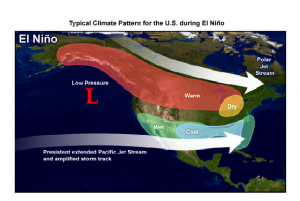.
.
From the Article by Jessica Corbett, Common Dreams, May 19, 2023
.
.
With experts anticipating El Niño will return in the months ahead, a pair of Dartmouth College researchers warned this week that the long-term cost to the global economy could be as much as $3 trillion by 2029 — which could be largely felt by poorer countries.
The El Niño-Southern Oscillation (ENSO), a climate pattern that affects sea surface temperatures across the tropical Pacific Ocean, has three phases: the cooler La Niña; neutral, which the world is now experiencing; and the warmer El Niño that is expected soon.
“El Niño triggers far-reaching changes in weather that result in devastating floods, crop-killing droughts, plummeting fish populations, and an uptick in tropical diseases,” explained a Dartmouth statement about the study, published in the journal Science.
Doctoral candidate Christopher Callahan and Justin Mankin, an assistant professor of geography at the college, examined economic conditions for several years after the 1982-83 and 1997-98 El Niño events. They connected those two warm phases to $4.1 trillion and $5.7 trillion in global income losses, respectively — far higher than previous estimates.
“El Niño amplifies the wider inequities in climate change, disproportionately impacting the least resilient and prepared among us.mWe can say with certainty that societies and economies absolutely do not just take a hit and recover,” said Callahan, the study’s lead author, noting that their data suggest an El Niño-related downturn could last up to 14 years or longer.
“In the tropics and places that experience the effects of El Niño, you get a persistent signature during which growth is delayed for at least five years,” he continued. “The aggregate price tag on these events has not ever been fully quantified — you have to add up all the depressed growth moving forward, not just when the event is happening.”
The pair found that the gross domestic product of the United States was roughly 3% lower in 1988 and 2003 than it would have been without the preceding El Niño events— and, for the latter phase, GDPs in coastal tropical countries were more than 10% lower.
“The global pattern of El Niño’s effect on the climate and on the prosperity of different countries reflects the unequal distribution of wealth and climate risk — not to mention the responsibility for climate change — worldwide,” said Mankin. “El Niño amplifies the wider inequities in climate change, disproportionately impacting the least resilient and prepared among us.”
“The duration and magnitude of the financial repercussions we uncovered suggests to me that we are maladapted to the climate we have,” he added. “Our accounting dramatically raises the cost estimate of doing nothing. We need to both mitigate climate change and invest more in El Niño prediction and adaptation because these events will only amplify the future costs of global warming.”
Callahan and Mankin’s study was released the same day as research published in the journal Nature Reviews Earth and Environment that found human-caused global heating has likely made El Niños and La Niñas “more frequent and more extreme.”
Models for the latter research showed that sea surface temperature extremes were about 10% more intense for the six decades after 1960, compared with the previous 60 years. Co-author Mike McPhaden, a senior research scientist at the U.S. National Oceanic and Atmospheric Administration (NOAA), said that “the big events pack the most punch, so even though 10% doesn’t sound like much, it juices up the strongest and most societally relevant year-to-year climate fluctuation on the planet.”
“In practical terms, this translates into more extreme and frequent droughts, floods, heatwaves, wildfires, and severe storms, just like we observed during the recent triple dip La Niña that ended in March,” McPhaden told The Guardian.
Given that observed trend and expectations it will continue, the Dartmouth researchers project that even if countries pursue their pledges to cut planet-heating emissions, global economic losses related to El Niño could reach $84 trillion for the 21st century.
“Our welfare is affected by our global economy, and our global economy is tied to the climate,” he said. “When you ask how costly climate change is, you can start by asking how costly climate variation is. We’re showing here that such variation, as embodied in El Niño, is incredibly costly and stagnates growth for years, which led us to cost estimates that are orders of magnitudes larger than previous ones.”
The Associated Press reported that “some — but not all — outside economists have issues with the new research out of Dartmouth College, saying its damage estimates are too big.” However, McPhaden welcomed the findings, telling the AP that he has long believed previous estimates were far too low and the “big loser during El Niño is the Global South.”
While the Dartmouth projections suggest 2023′s looming warm phase could cost trillions of dollars, the NOAA scientist stressed that “the economic impacts of the El Niño that is predicted for later this year will depend on how strong it is.”
“Monster El Niños” like the 1997-98 event “can be hugely damaging with lingering effects that carry over into following years,” he said. “On the other hand, if it turns out to be a garden variety El Niño, the consequences may be more muted and the recovery time shortened.”
#######+++++++#######+++++++#######
See Also: ENSO: Recent Evolution, Current Status and Predictions ~ Update prepared by: Climate Prediction Center / NCEP, 22May2023


{ 1 comment… read it below or add one }
Summary ~ ENSO Alert System Status: El Niño Watch ENSO-neutral conditions are observed.*
Equatorial sea surface temperatures (SSTs) are near-to-above average across most of the Pacific Ocean.
A transition from ENSO-neutral is expected in the next couple of months, with a greater than 90% chance of El Niño persisting into the Northern Hemisphere winter.*
* Note: These statements are updated once a month (2nd Thursday of each month) in association with the ENSO Diagnostics Discussion, which can be found by clicking here.
https://www.cpc.ncep.noaa.gov/products/analysis_monitoring/lanina/enso_evolution-status-fcsts-web.pdf